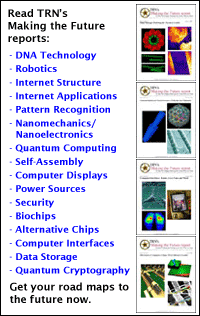
Artificial
crystals change laser colors
By
Eric Smalley,
Technology Research NewsThe physical properties of materials are intricately linked to the three-dimensional arrangements of their atoms and molecules. Generations of scientists have studied existing materials in order to understand the relationship between structure and properties.
Recently researchers have begun applying this knowledge to create new materials that have useful magnetic, electrical and optical properties.
A team of researchers at the University of Minnesota have concocted a crystal that changes the color of laser light by doubling its frequency, for instance changing red to green or blue. Red lasers are easier and cheaper to make than green or blue lasers.
The crystal has this property of second harmonic generation because it is polarized, or magnetically aligned, said Michael D. Ward, a professor of chemical engineering and materials science at the University of Minnesota. "Polarity can be loosely thought of as having all of the atomic or molecular building blocks of the solid point in roughly the same direction, like arrows," he said.
Neighboring atoms and molecules in crystals are ordinarily arranged with their positive and negative magnetic poles opposite each other, much like the way ordinary kitchen magnets stack together. The trick to creating a polar crystal is figuring out how to force the crystal's molecules to line up with their positive ends adjacent to each other and their negative ends adjacent to each other.
"The native structures of the pure [material] do not display the required polar alignment for second harmonic generation, and so the challenge was to build a material that could force them into a polar arrangement," said Ward.
The researchers' solution was to build a crystal that served as a framework, or host, containing guest molecules that, when properly arranged, have this property. The framework crystal can be manipulated to orient the guest molecules contained in its cells.
The layers of the crystal framework are similar to a stack of patterned plates, with each successive plate pattern aligned in the opposite direction. The researchers figured out how to rotate every other host crystal layer and lock them into a new configuration along with the guest molecules they held. This altered arrangement oriented the guest molecules in the polar alignment.
The researchers were aiming to create an artificial crystal with the second harmonic generation property rather than produce a crystal with immediate practical applications, said Ward. "The goal was to design a material that is capable of exhibiting this property."
Precisely controlling crystal symmetry could eventually lead cheaper or more efficient materials for data storage, optical communications networks and drug screening.
The researchers plan to create polar crystals with other guest and host materials. Practical applications for the artificial materials, however, are "far in the future," Ward said.
Ward's research colleagues were K. Travis Holman and Adam M. Pivovar of the University of Minnesota. They published the research in the November 30, 2001 issue of the journal Science. The research was funded by the National Science Foundation, the Natural Sciences and Engineering Research Council of Canada and the University of Minnesota.
Timeline: Unknown
Funding: Government, University
TRN Categories: Materials Science and Engineering; Optical Computing, Optoelectronics and Photonics
Story Type: News
Related Elements: Technical paper, "Engineering Crystal Symmetry and Polar Order in Molecular Post Frameworks," Science, November 30, 2001
Advertisements:
January 23, 2002
Page One
Laser speeds data through air
Nanotube array could form chips
Hot spots give away lying eyes
Quantum data compares faster
Artificial crystals change laser colors
News:
Research News Roundup
Research Watch blog
Features:
View from the High Ground Q&A
How It Works
RSS Feeds:
News
Ad links:
Buy an ad link
| Advertisements:
|
 |
Ad links: Clear History
Buy an ad link
|
TRN
Newswire and Headline Feeds for Web sites
|
© Copyright Technology Research News, LLC 2000-2006. All rights reserved.